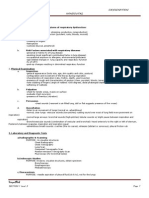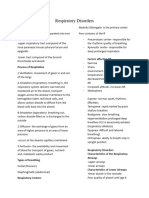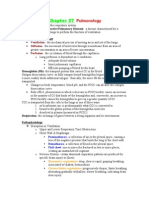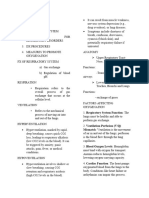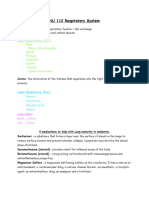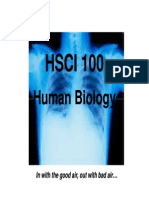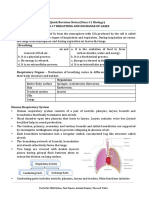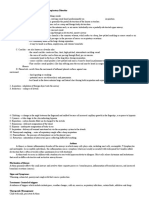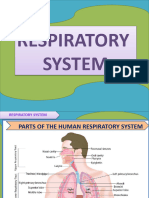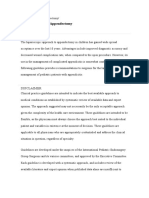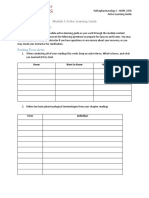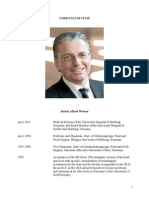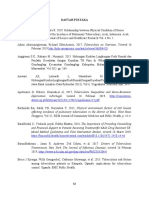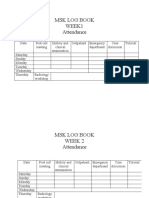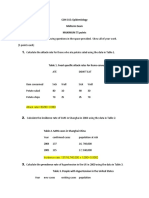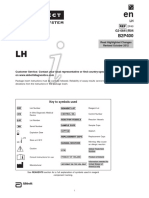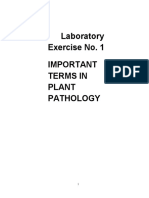The Process of Oxygenation
The Process of Oxygenation
Uploaded by
api-3744683Copyright:
Available Formats
The Process of Oxygenation
The Process of Oxygenation
Uploaded by
api-3744683Original Description:
Copyright
Available Formats
Share this document
Did you find this document useful?
Is this content inappropriate?
Copyright:
Available Formats
The Process of Oxygenation
The Process of Oxygenation
Uploaded by
api-3744683Copyright:
Available Formats
JARO, KARLEEN L.
BSN 3-AI
THE PROCESS OF OXYGENATION
− Delivery of oxygen to the body
− Depends upon the interplay of pulmonary, hematologic and cardiovascular system
− Processes involved are ventilation, alveolar gas exchange, oxygen transport and cellular respiration.
I. VENTILATION
− First step in the process of oxygenation
− Movement of air into and out of the lungs for the purpose of delivering fresh air in the alveoli
− Regulated by the respiratory centers in the pons and medulla oblongata.
− Rate and depth depends on the concentrating hydrogen ion and carbon dioxide (CO2) in body and fluid
Mechanics of Ventilation
1. Air Pressure Variances
Air flows from region of higher pressure to a region of lower pressure. During inspiration, movement of
diaphragm and other muscles of respiration enlarge the thoracic cavity and thereby lower the pressure inside the
thorax to a level below that of the atmospheric pressure.
During the normal expiration, the diaphragm relaxes and the lungs recoil. The alveolar pressure then exceeds
atmospheric pressure, and air flows from the lungs into the atmosphere.
2. Air Way Resistance
Any process that changes the bronchial diameter or widths affects airway resistance and alters the rate of airflow
for a given pressure gradient during respiration.
3. Compliance
It measures the (characteristics of lungs) elasticity, expandability, and distensibility of the lungs and thoracic
structures. It is determined by examining the volume-pressure relationship in the lungs and the thorax. In normal
compliance, the lungs and the thorax easily stretch and distend when pressure is applied. High or increased
compliance occurs when the lungs have lost their elasticity and the thorax is distended. When lungs and thorax are
stiff, there is low or decreased compliance.
II. ALVEOLAR GAS EXCHANGE (oxygen uptake or external respiration)
Once fresh air reaches the lung’s alveoli, oxygen moves from area of higher concentration (alveoli) to lower
concentration (pulmonary capillary blood). The same way that CO2 diffuses from the blood to the alveolar space.
III. OXYGEN TRANSPORT
Once the diffusion of oxygen across the alveolar-capillary membrane occurs, the CO2 molecules are dissolved in the
blood plasma. Plasma is not able to carry enough dissolved oxygen to meet the metabolic needs of the body. Oxygen
carrying capacity of the blood is greatly enhanced by the presence of hemoglobin in the erythrocytes. Once oxygen is
bound to hemoglobin, the oxygen is delivered to the cell of the body by circulation
Hemoglobin – RBC’s major component which contains heme, a complex molecule of iron and porphyrin which gives
blood its color and globin, a simple protein
Hemoglobin Test – Measures the grams of hemoglobin in a 100ml of whole blood.
Normal Values: Males 14.0 – 17.4 g/dL Females 12.0 – 16.0 g/dL
13.5 – 17.5 g/dL 11.5 – 15.5 g/dL
Measurement of Oxygen in Blood Samples
1. Partial Pressure of Oxygen (PaO2)
– measures oxygen dissolved in plasma. Normal Value: 80 – 100 mmHg
2. Oxygen Saturation (SaO2)
– measures the percentage of hemoglobin saturated with oxygen. Normal Value: 95 – 100 %
96 – 98%
2nd Sem Midterm 2006-2007 OXYGENATION Ms. Norma Mercado, RN 1
JARO, KARLEEN L. BSN 3-AI
IV. CELLULAR RESPIRATION
Gas exchange at the cellular level takes place via diffusion in response to pressure gradient. Oxygen diffuses from
the blood to the tissues while carbon dioxide moves from the tissues to the blood. Blood is reoxygenated.
FACTORS AFFECTING OXYGENATION
1. Age
Older adults often exhibit barrel chest and require increased effort to expand the lung. They are also
susceptible to respiratory infection due because of decreased activity which is an effective defense mechanism.
2. Environmental and lifestyle factors
Clients who are exposed to dust, animal dander, asbestos or toxic chemicals are at an increased risk for
alterations in oxygenation. Smokers as well as those exposed to it should be questioned as to the type,
frequency of smoking.
3. Disease processes
ASSESSMENT OF CLIENT WITH RESPIRATORY DISORDERS
HEALTH HISTORY
− Identify the chief reason for seeking health care
− Nurse determines when the health problems started, how long it lasted, if it was relieved any time, and how relief
was obtained.
− Collects information about precipitating factors, duration, severity and associated factors or symptoms
− Assess risk factors and genetic factors that contribute to the condition
− Assess the impact of sign and symptoms on the patient’s ability to perform activities of daily living
SIGNS AND SYMPTOMS
Dyspnea – difficulty or labored breathing, shortness of breath to any constantly recurring irritant
Cough – results from the irritation of mucous membrane anywhere in the respiratory tract. It may arise from infectious
process and from airborne irritants such as smoke, dust and gas
Sputum Production – reaction of lungs to any constantly recurring irritants
Chest Pain – sharp, stabbing and intermittent or may be dull, aching and persistent
Wheezing – high pitched musical sound heard mainly on expiration. (bronchoconstriction or airway narrowing)
Clubbing Fingers – found in clients with chronic hypoxic condition, chronic lung infection and malignancies of the
lungs. It is described as sponginess of the nail bed and loss of nail bed angle
Hemoptysis – expectoration of blood from respiratory tract. A symptom of both pulmonary and cardiac disorder
Cyanosis – bluish discoloration of the skin. It is a late sign of hypoxia (can lead to shock or death). Cyanosis appears of
there is 5 g/dL of unoxygenated hemoglobin
PHYSICAL ASSESSMENT OF UPPER RESPIRATORY STUCTURES
1. Nose and Sinuses
− inspect the external nose for lesions, asymmetry or inflammation
− examine the internal structure for swelling, color, exudates or bleeding
− inspect for septum deviation, perforation or bleeding
2nd Sem Midterm 2006-2007 OXYGENATION Ms. Norma Mercado, RN 2
JARO, KARLEEN L. BSN 3-AI
− palpate the frontal and maxillary sinuses for tenderness. Using the thumb the nurse applies gentle pressure in an
upward fashion at the supraorbital ridges (frontal sinuses) and in the cheek area adjacent to the nose (maxillary).
Tenderness suggests inflammation
2. Pharynx and Mouth
− Instruct the client to open mouth and take deep breath
− Inspect structures for color, symmetry and evidence of exudates, ulceration or enlargement
3. Trachea
− Place thumb and index finger of one hand on either side of the trachea just above the sternal notch. It is
normally in the midline as it enters the thoracic inlet behind the sternum.
PHYSICAL ASSESSMENT OF UPPER RESPIRATORY STUCTURES
1. CHEST CONFIGURATION – normal ratio of the antero posterior diameter to lateral diameter is 1:2
Barrel Chest – increase in the antero posterior diameter of the thorax, ribs are more widely spaced and the
intercostals space tend to bulge
Funnel Chest – (pectus excavatum) depression of the lower portion of the sternum
Pigeon Chest – results from displacement of sternum. There is an increase in the anterior diameter.
Kyphoscolosis – elevation of the scapula and a corresponding S shaped spine
2. BREATHING PATTERNS AND RESPIRATORY RATE
Eupnea – normal breathing 12-18 bpm
Bradypnea – slower than normal <10 bpm normal depth and regular rhythm
Tachypnea – rapid, shallow >24 bpm
Apnea – cessation of breathing
Kussmaul’s – increased rate and depth of breathing
Cheyne-Stokes – regular cycle where the rate and depth of breathing increase and then decrease until apnea
(usually 20 seconds) *tachypnea – stop – tachypnea – stop – tachypnea – flat line
Biot’s Respiration – period of normal breathing (3-4 breaths) followed by varying period of apnea (usually 10
seconds to 1 minute) *shallow – deep – irregular
3. BREATH SOUNDS
Crackles – formerly known as rales, are discrete non continuous sounds that result from delayed reopening of
deflated airways. Soft high itched sound heard during inspiration
Coarse Crackles – discontinuous popping sound heard in early inspiration; harsh moist sound originating in the
large bronchi
Fine Crackles – discontinuous popping sound heard in late inspiration; sound like hair rubbing together
Sonorous Wheezes (ronchi) – deep low-pitched rumbling sound heard primarily during expiration; caused by air
moving through narrowed tracheo bronchial passages
Sibilant Wheezes – continuous, musical, high pitched, whistle like sounds hears during inspiration and expiration
caused by air passing through narrowed or partially obstructed airways may clear without
coughing.
2nd Sem Midterm 2006-2007 OXYGENATION Ms. Norma Mercado, RN 3
JARO, KARLEEN L. BSN 3-AI
Friction Rubs – harsh crackling sound, like two pieces of leather being rubbed together. Heard during inspiration
alone or during both inspiration and expiration
DIAGNOSTIC PROCEDURES
1. Pulmonary Function Tests
− Performed to assess respiratory function and to determine the extent of dysfunction
− Generally performed by a technician using spirometer that has a volume collecting device attached to a
recorder. It measures lung volume, ventilatory function and the mechanics of breathing, diffusion and gas
exchange. PFT results are interpreted on the basis of the degree of deviation from normal.
2. Arterial Blood Gas
− ABG levels are obtained thru an arterial puncture at the radial, brachial or femoral artery. It measures arterial
oxygen tension (PaO2) w/c indicates the degree of oxygenation of the blood and arterial carbon dioxide pressure
(PaCO2) indicates adequacy of alveolar ventilation. It also measures the body’s ability to maintain normal pH.
Normal Values:
pH 7.35 – 7.45 indicates acid-base balance
HCO3 22 – 26 mEq/L indicates metabolic component of acid base balance
PaCO2 35 – 45 mmHg indicates adequacy of alveolar ventilation
PaO2 80 – 100 mmHg represents oxygen dissolved in plasma
SaO2 95 – 100% saturation of hemoglobin with oxygen
3. Pulse Oximetry
− Non invasive method of continuously monitoring the oxygen saturation of hemoglobin (SaO2)
− A probe or sensor is attached to the fingertip, forehead, earlobe or bridge of the nose. The sensor detects
changes in oxygen saturation levels by monitoring light signals generated by the oximeter
− Normal value: 95 – 100%
− Values less than 85% indicates that tissues are not receiving enough oxygen
4. Capnography
− End-tidal CO2 monitoring
− Measures amount of CO2 expired with each breath
5. Ventilation-Perfusion Studies
6. Chest X-Ray
− Normal pulmonary tissues are radioluscent
− May reveal densities indicating pathologic process
− Taken after full inspiration because the lungs are best visualized when aerated
7. Pulmonary Angiography
− Most commonly used to identify thromboembolic disease of the lungs
− It involves rapid injection of a radiopaque agent into the vascula are of the lungs for radiographic study of the
pulmonary vessels
8. Cultures
− throat cultures may be performed to identify organisms responsible for pharyngitis
9. Sputum Studies
− Used to identify pathogenic organisms and to determine whether malignant cells are present
− Expectoration is the usual method for collecting sputum specimen
2nd Sem Midterm 2006-2007 OXYGENATION Ms. Norma Mercado, RN 4
JARO, KARLEEN L. BSN 3-AI
− Specimen is obtained early in the morning after they have accumulated overnight
− The patient is instructed to clear the nose and throat rise the mouth to decrease contamination of the sputum.
After taking few deep breaths, the patient coughs rather than spits.
− The specimen is delivered to the laboratory within two hours.
10. Computed Tomography (CT Scan)
− An imaging method in which the lungs are scanned in successive layers by narrow-beam x-ray
− It can distinguish fine tissue density
− May be used to define pulmonary nodules and small tumors adjacent to pleural surfaces that are not visible to
routine chest x-ray
11. Magnetic Resonance Imaging
− Similar to CT Scan except that magnetic fields and radio frequency signals are used instead of narrow beam x-
ray
− Yields are more detailed diagnostic image than CT Scan
12. Fluoroscopic Studies
− Used to assist in invasive procedure such as chest needle biopsy or transbronchial biopsy
2nd Sem Midterm 2006-2007 OXYGENATION Ms. Norma Mercado, RN 5
You might also like
- PDF Lippincott Biochemistry DL - PDFDocument209 pagesPDF Lippincott Biochemistry DL - PDFMarian George MateiNo ratings yet
- OXYGENATIONDocument8 pagesOXYGENATIONJo Marchianne Pigar0% (1)
- NCM 112 OXYGENATION - HandoutDocument9 pagesNCM 112 OXYGENATION - Handoutissaiahnicolle100% (1)
- Alcohol Screening TestDocument3 pagesAlcohol Screening Testitsme_rizaNo ratings yet
- The Process of OxygenationDocument7 pagesThe Process of OxygenationMich CercadoNo ratings yet
- Responses To Altered Respiratory FunctionDocument19 pagesResponses To Altered Respiratory FunctionKoleen KirstenNo ratings yet
- Interventions To Promote OxygenationDocument19 pagesInterventions To Promote OxygenationMary Ann SacramentoNo ratings yet
- Medsurg RespiDocument38 pagesMedsurg Respij UNo ratings yet
- Care of A Child With RespiratoryDocument185 pagesCare of A Child With RespiratoryVanessa Lopez100% (1)
- Breathing and Respiration NotesDocument6 pagesBreathing and Respiration NotesAditya UpadhyayNo ratings yet
- Prelims Oxygenation Handout#2Document5 pagesPrelims Oxygenation Handout#2ApRil Anne BalanonNo ratings yet
- Respi Anaphy Day 1Document128 pagesRespi Anaphy Day 1Tracy Megan RusillonNo ratings yet
- Notes of Human Physiology Class 11Document9 pagesNotes of Human Physiology Class 11ADWAITH LALU100% (1)
- Chapter 2 Respiratory AssessmentDocument9 pagesChapter 2 Respiratory AssessmentKathleen Dela CruzNo ratings yet
- Oxygen Insufficiency ASSINGMNT 40 PGDocument23 pagesOxygen Insufficiency ASSINGMNT 40 PGpritiiskappeshajapurNo ratings yet
- Functional Anatomy of The Respiratory SystemDocument3 pagesFunctional Anatomy of The Respiratory SystemRica Mae TingcoNo ratings yet
- Respiratory SystemDocument12 pagesRespiratory Systemab4943409No ratings yet
- Respiratory Nursing #1Document19 pagesRespiratory Nursing #1shenric16100% (13)
- Respiratory DisordersDocument50 pagesRespiratory Disordersmerldenandreagonzales13No ratings yet
- Respiratory DisordersDocument5 pagesRespiratory Disorderskylealexis007No ratings yet
- Concept Presentation ON Oxygen InsufficiencyDocument95 pagesConcept Presentation ON Oxygen Insufficiencylumina.sNo ratings yet
- Chapter 27Document6 pagesChapter 27monster40lbsNo ratings yet
- OXYGINATION FUNDA LEC BebeDocument8 pagesOXYGINATION FUNDA LEC BebediarosedoloresbsncNo ratings yet
- Assessment On RSDocument13 pagesAssessment On RSavinash dhameriyaNo ratings yet
- Breathing and Exchange of GasesDocument5 pagesBreathing and Exchange of Gaseslpc4944No ratings yet
- Respiratory DisorderDocument76 pagesRespiratory DisorderMohamed HamdyNo ratings yet
- The Respiratory System (Intro)Document75 pagesThe Respiratory System (Intro)Krestel Saligumba PalanogNo ratings yet
- Respiratory System 1Document33 pagesRespiratory System 1Arianne Jen Genotiva100% (1)
- Breathing and Body Fluids RevisionDocument15 pagesBreathing and Body Fluids Revisionakshitarao4960No ratings yet
- Respiratory Physiology PostedDocument25 pagesRespiratory Physiology PostedYeni PuspitaNo ratings yet
- NU 112 Respiratory System NotesDocument11 pagesNU 112 Respiratory System NotesconstantinoNo ratings yet
- NCM 112 LEC Topic 2 Oxygenation Current Health History Physical Examination Normal Abnormal Breath Sounds Breathing PatternsDocument7 pagesNCM 112 LEC Topic 2 Oxygenation Current Health History Physical Examination Normal Abnormal Breath Sounds Breathing PatternsViviene Faye FombuenaNo ratings yet
- Nursing Management of Patient With Respiratory ProblemsDocument151 pagesNursing Management of Patient With Respiratory ProblemsAbirajan100% (3)
- Organ System For The Exchange of GasesDocument7 pagesOrgan System For The Exchange of GasesALWEN ROSE CARILLONo ratings yet
- Tina ThankachanDocument50 pagesTina ThankachanBharat JamodNo ratings yet
- Respiratory SystemDocument192 pagesRespiratory SystemQuolette Constante100% (1)
- CHAPTER - Breathing and Exchange of GasesDocument5 pagesCHAPTER - Breathing and Exchange of Gasesdevilsakshi748No ratings yet
- HSCI 100 HSCI 100: Human Biology Human Biology Human Biology Human BiologyDocument18 pagesHSCI 100 HSCI 100: Human Biology Human Biology Human Biology Human BiologyRosa ChoNo ratings yet
- 2018 Respiratory System HandoutDocument10 pages2018 Respiratory System HandoutMr. DummyNo ratings yet
- Oxygenation and Orygen TherapyDocument87 pagesOxygenation and Orygen Therapyபிரேம் குமார் ராஜாமணிNo ratings yet
- Structural and Functional Organization of The Respiratory System. Stages of Respiration. Regulation of RespirationDocument39 pagesStructural and Functional Organization of The Respiratory System. Stages of Respiration. Regulation of RespirationMohammed Faizuddin siddiquiNo ratings yet
- Obstructive Disease of Lung and Physiotherapy ManagementDocument76 pagesObstructive Disease of Lung and Physiotherapy Managementphysio43100% (1)
- Respiratory SystemDocument53 pagesRespiratory SystemRotan CirebonNo ratings yet
- Respiratory SystemDocument38 pagesRespiratory Systemjsreyes.402No ratings yet
- Oxygenation Respiratory Function & Cardiovascular SystemDocument41 pagesOxygenation Respiratory Function & Cardiovascular SystemcorneliusanwarNo ratings yet
- Pulmonary SystemDocument75 pagesPulmonary Systemangeles_robert_71No ratings yet
- 11 Biology Notes Ch17 Breathing and Exchange of GasesDocument4 pages11 Biology Notes Ch17 Breathing and Exchange of GasesParimala devi0% (1)
- 2013 Oxygenation UpdatedDocument310 pages2013 Oxygenation UpdatedAngeline Dela CruzNo ratings yet
- Module 7-11 The Respiratory SystemDocument52 pagesModule 7-11 The Respiratory SystemAlfred James SorianoNo ratings yet
- MCN CompiledDocument71 pagesMCN CompiledJœnríčk AzueloNo ratings yet
- CU11 Funda Week 13 Respiratory SystemDocument70 pagesCU11 Funda Week 13 Respiratory System97fcqmnnmnNo ratings yet
- Respiratory SystemDocument7 pagesRespiratory SystemxoxogeloNo ratings yet
- Lec1 of Symptomatology of Chest DiseasesDocument26 pagesLec1 of Symptomatology of Chest Diseasesmenna hanyNo ratings yet
- Reviewer For Management of Common IllnessDocument27 pagesReviewer For Management of Common Illnessmarie vennis hamchawanNo ratings yet
- The Respiratory System: ASTIKA NUR ROHMAH, S.Kep., NS., M.BiomedDocument43 pagesThe Respiratory System: ASTIKA NUR ROHMAH, S.Kep., NS., M.BiomedAdek KhazeliaNo ratings yet
- Oxygen InsufficiencyDocument16 pagesOxygen Insufficiencydeolzf100% (1)
- Respiratory SystemDocument43 pagesRespiratory SystemMaxxdlc 16No ratings yet
- Chapter 10 Respiratory System PresentationDocument48 pagesChapter 10 Respiratory System PresentationMary Jane LubricoNo ratings yet
- Respiratory System NurDocument38 pagesRespiratory System Nurimtiaz7254No ratings yet
- Gmail - Whitney Hendrickson - 7-12-23Document2 pagesGmail - Whitney Hendrickson - 7-12-23Anthony DocKek PenaNo ratings yet
- IPEG Guidelines - AppendicitisDocument12 pagesIPEG Guidelines - AppendicitisHeru Sutanto KNo ratings yet
- Disturbed Sleep PatternDocument2 pagesDisturbed Sleep Patternmaria_magno_6100% (1)
- Management of Patient With: BurnsDocument87 pagesManagement of Patient With: BurnsThea Dino100% (2)
- Module 1 Active Learning GuideDocument4 pagesModule 1 Active Learning GuideKamil MominNo ratings yet
- Curriculum Vitae Werner EnglDocument13 pagesCurriculum Vitae Werner EngldiarioepocaNo ratings yet
- Candida Emotional Causes - Hanna Kroeger Healer - Natural and Vibrational HealingDocument5 pagesCandida Emotional Causes - Hanna Kroeger Healer - Natural and Vibrational HealingAnish Shakya100% (1)
- Session 1 - Pathophysiology and Classification of Thalassemia - Prof. Dr. Manzur MorshedDocument33 pagesSession 1 - Pathophysiology and Classification of Thalassemia - Prof. Dr. Manzur MorshedShahidul Islam ChowdhuryNo ratings yet
- 1st Aid SOPDocument9 pages1st Aid SOPDon Mclean100% (1)
- Daftar PustakaDocument6 pagesDaftar PustakaChintiaNo ratings yet
- Spinal Shock.Document12 pagesSpinal Shock.bosnia agusNo ratings yet
- MSK Log BookDocument6 pagesMSK Log BookMasod HajiNo ratings yet
- Ear Surgery: Tympanoplasty, Mastoidectomy: Patient Postoperative Instructions and InformationDocument4 pagesEar Surgery: Tympanoplasty, Mastoidectomy: Patient Postoperative Instructions and InformationPaul Jordan SandaloNo ratings yet
- The Biomedical Basis of Chronic DiseasesDocument17 pagesThe Biomedical Basis of Chronic DiseasesJoshMatthewsNo ratings yet
- Newborn Bathing ...Document3 pagesNewborn Bathing ...alloushi100% (3)
- COH 315: Epidemiology Midterm Exam MAXIMUM 75 Points: Attack Rate 80/90 0.889Document5 pagesCOH 315: Epidemiology Midterm Exam MAXIMUM 75 Points: Attack Rate 80/90 0.889Farah FarahNo ratings yet
- Mental Health and Mental DisordersDocument29 pagesMental Health and Mental DisordersTet Velchez100% (1)
- Lecture 13 (Mtap Notes)Document55 pagesLecture 13 (Mtap Notes)Ma. Mecy COMAHIGNo ratings yet
- Bacterial Transfer Associated With Blowing Out Candles On A Birthday CakeDocument5 pagesBacterial Transfer Associated With Blowing Out Candles On A Birthday CakeWSETNo ratings yet
- Acute CoughDocument5 pagesAcute CoughSundar RamanathanNo ratings yet
- Distal Radial Access For Coronary Angiography and Percutaneous Coronary Intervention: A State-Of-The-Art ReviewDocument6 pagesDistal Radial Access For Coronary Angiography and Percutaneous Coronary Intervention: A State-Of-The-Art ReviewDeebanshu GuptaNo ratings yet
- Klebsiella Infections Treatment & ManagementDocument5 pagesKlebsiella Infections Treatment & ManagementCecilia GrunauerNo ratings yet
- LH Assay InsertDocument8 pagesLH Assay InsertYogaswara AdiputroNo ratings yet
- Lab CRPRDocument13 pagesLab CRPRdarryl calingacionNo ratings yet
- PR Truenat WHO Endorsement 02072020Document4 pagesPR Truenat WHO Endorsement 02072020KantiNareshNo ratings yet
- (REV) JMEDS00217 - PageproofDocument5 pages(REV) JMEDS00217 - PageproofAnonymous UHnQSkxLBDNo ratings yet
- Gestational Diabetes MellitusDocument73 pagesGestational Diabetes Mellitusreniere lagazoNo ratings yet
- Physical Fitness Form Employment CertificateDocument1 pagePhysical Fitness Form Employment CertificateStanly stephenNo ratings yet










